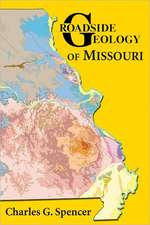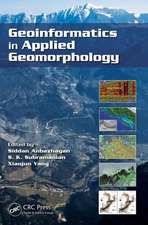Marine Protected Areas: Science, Policy and Management
Editat de John Humphreys, Robert Clarken Limba Engleză Paperback – 18 oct 2019
Those in theory, designation, implementation or management of MPAs, from individuals, marine sector organizations, and university and research center libraries will find it an important work.
- Provides a much needed ‘one stop shop’ for information on Marine Protected Areas
- Presents chapters from a diverse group of contributors, enabling a broad and deep perspective
- Includes case studies throughout, providing real-life examples and best practice recommendations
Preț: 819.26 lei
Preț vechi: 1062.11 lei
-23% Nou
Puncte Express: 1229
Preț estimativ în valută:
156.77€ • 167.64$ • 130.71£
156.77€ • 167.64$ • 130.71£
Carte tipărită la comandă
Livrare economică 10-24 aprilie
Preluare comenzi: 021 569.72.76
Specificații
ISBN-13: 9780081026984
ISBN-10: 0081026986
Pagini: 828
Dimensiuni: 191 x 235 x 47 mm
Greutate: 1.4 kg
Editura: ELSEVIER SCIENCE
ISBN-10: 0081026986
Pagini: 828
Dimensiuni: 191 x 235 x 47 mm
Greutate: 1.4 kg
Editura: ELSEVIER SCIENCE
Public țintă
Marine oceanographers, marine conservationists, Marine biologists, marine management practitioners, Aquatic EcologistsCuprins
Foreword: Progress towards the conservation and sustainable use of the oceasn: targets and challenges
Preface
Acknowledgements
PART ONE: POLICY
1. A critical history of marine protected areas
2. Marine protected areas and marine spatial planning - allocation of resource use and environmental protection
3. Challenges facing marine protected areas in Southern African countries in light of the expanding ocean economies in the sub-region
4. The South Orkney Islands Southern Shelf Marine Protected Area: towards the establishment of marine spatial protection within the international waters in the Southern Ocean
5. Uneasy Bedfellows: Fisheries and the search for space for Marine Conservation Zones in English Waters
6. The role of coastal communities in the sustainable management of marine protected areas
7. The use of natural capital in the choice, management and evaluation of MPAs
8. Some consequences of policy instabilities for marine protecred area management
9. Managing marine protected areas in Europe: moving from 'feature-based' to 'whole-site; management of sites
10. The role of UK Marine Protected Area management in contributing to sustainable development in the marine environment
11. The law and marine protected areas: different regimes and their practical impacts in England
12. Marine protected areas in the UK - conservation or recovery?
13. South Africa's Tsitsikamma Marine Protected Area - winners and losers
PART TWO: MANAGEMENT
14. Developing a fisheries management plan for the Pitcairn Islands Marine Protected Area
15. Countering the threat of invaive species to the Galapagos marine reserve
16. Balancing rural development and robust nature conservation - lessons learnt from Kosterhavet Marine National Park, Sweden
17. The Torre Guaceto marine protected area e what can we learn from this success story?
18. The challenges of establishing marine protected areas in South East Asia
19. Have you seen the dolphins? Dolphin watching participatory monitoring in a Brazilian multiple-use Marine Protected Area
20. A new approach to monitoring Marine Protected Area Management Success in the Dutch Caribbean
21. Crossing jurisdictions: the implementation of offshore marine protected areas in an international fishery
22. A net positive effect? Assessing the impact on fishing opportunities within multiple-use MPAs. A case study from Scotland
23. Managing a dredge fishery within a marine protected area: resolving environmental and socio-economic objectives
24. Marine protected areas - the importance of positive partnerships and stakeholder engagement for delivering environmental outcomes in an estuary
25. Enforcement capabilities and compliance in English Marine Protected Areas: the art of the possible
PART THREE: SCIENCE
26. Using science effectively: selection, design and management of marine protected areas
27. How new science should affect the application of protection measures for UK estuarine shorebirds
28. Verifying predictions of statistical models to define the size and shape of marine Special Protection Areas for foraging seabirds (terns)
29. Developments in understanding of red-throated diver responses to offshore wind farms in marine Special Protection Areas
30. Sediment transport and Marine Protected Areas
31. On sediment dispersal in the Whitsand Bay Marine Conservation Zone: neighbour to a closed dredge-spoil disposal site
32. Maintaining ecological resilience on a regional scale: coastal saline lagoons in a northern European marine protected area
33. The adaptive capacity of the willow (Salix alba L.) to bridge the gap between MPAs and harbour entrances
34. Palaeoenvironmental determination of biogeochemistry and ecological response in an estuarine marine protected area
35. Consequences of nitrate enrichment in a temperate estuarine marine protected area; response of the microbial primary producers and consequences for
management
36. Macroalgal mats in a eutrophic estuarine marine protected area: implications for benthic invertebrates and wading birds
37. Assessing the benefits of shellfish aquaculture in improving water quality in Poole Harbour, an estuarine Marine Protected Area
38. Nitrogen pollution in coastal Marine Protected Areas: a river catchment partnership to plan and deliver targets in a UK estuarine Special Protection Area
PART FOUR: CONCLUDING REMARKS
39. Marine Protected Areas: Quo Vadis?
Preface
Acknowledgements
PART ONE: POLICY
1. A critical history of marine protected areas
2. Marine protected areas and marine spatial planning - allocation of resource use and environmental protection
3. Challenges facing marine protected areas in Southern African countries in light of the expanding ocean economies in the sub-region
4. The South Orkney Islands Southern Shelf Marine Protected Area: towards the establishment of marine spatial protection within the international waters in the Southern Ocean
5. Uneasy Bedfellows: Fisheries and the search for space for Marine Conservation Zones in English Waters
6. The role of coastal communities in the sustainable management of marine protected areas
7. The use of natural capital in the choice, management and evaluation of MPAs
8. Some consequences of policy instabilities for marine protecred area management
9. Managing marine protected areas in Europe: moving from 'feature-based' to 'whole-site; management of sites
10. The role of UK Marine Protected Area management in contributing to sustainable development in the marine environment
11. The law and marine protected areas: different regimes and their practical impacts in England
12. Marine protected areas in the UK - conservation or recovery?
13. South Africa's Tsitsikamma Marine Protected Area - winners and losers
PART TWO: MANAGEMENT
14. Developing a fisheries management plan for the Pitcairn Islands Marine Protected Area
15. Countering the threat of invaive species to the Galapagos marine reserve
16. Balancing rural development and robust nature conservation - lessons learnt from Kosterhavet Marine National Park, Sweden
17. The Torre Guaceto marine protected area e what can we learn from this success story?
18. The challenges of establishing marine protected areas in South East Asia
19. Have you seen the dolphins? Dolphin watching participatory monitoring in a Brazilian multiple-use Marine Protected Area
20. A new approach to monitoring Marine Protected Area Management Success in the Dutch Caribbean
21. Crossing jurisdictions: the implementation of offshore marine protected areas in an international fishery
22. A net positive effect? Assessing the impact on fishing opportunities within multiple-use MPAs. A case study from Scotland
23. Managing a dredge fishery within a marine protected area: resolving environmental and socio-economic objectives
24. Marine protected areas - the importance of positive partnerships and stakeholder engagement for delivering environmental outcomes in an estuary
25. Enforcement capabilities and compliance in English Marine Protected Areas: the art of the possible
PART THREE: SCIENCE
26. Using science effectively: selection, design and management of marine protected areas
27. How new science should affect the application of protection measures for UK estuarine shorebirds
28. Verifying predictions of statistical models to define the size and shape of marine Special Protection Areas for foraging seabirds (terns)
29. Developments in understanding of red-throated diver responses to offshore wind farms in marine Special Protection Areas
30. Sediment transport and Marine Protected Areas
31. On sediment dispersal in the Whitsand Bay Marine Conservation Zone: neighbour to a closed dredge-spoil disposal site
32. Maintaining ecological resilience on a regional scale: coastal saline lagoons in a northern European marine protected area
33. The adaptive capacity of the willow (Salix alba L.) to bridge the gap between MPAs and harbour entrances
34. Palaeoenvironmental determination of biogeochemistry and ecological response in an estuarine marine protected area
35. Consequences of nitrate enrichment in a temperate estuarine marine protected area; response of the microbial primary producers and consequences for
management
36. Macroalgal mats in a eutrophic estuarine marine protected area: implications for benthic invertebrates and wading birds
37. Assessing the benefits of shellfish aquaculture in improving water quality in Poole Harbour, an estuarine Marine Protected Area
38. Nitrogen pollution in coastal Marine Protected Areas: a river catchment partnership to plan and deliver targets in a UK estuarine Special Protection Area
PART FOUR: CONCLUDING REMARKS
39. Marine Protected Areas: Quo Vadis?















